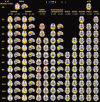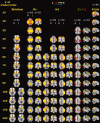The effect of model order selection in group PICA
- PMID: 20063361
- PMCID: PMC6871136
- DOI: 10.1002/hbm.20929
The effect of model order selection in group PICA
Abstract
Independent component analysis (ICA) of functional MRI data is sensitive to model order selection. There is a lack of knowledge about the effect of increasing model order on independent components' (ICs) characteristics of resting state networks (RSNs). Probabilistic group ICA (group PICA) of 55 healthy control subjects resting state data was repeated 100 times using ICASSO repeatability software and after clustering of components, centrotype components were used for further analysis. Visual signal sources (VSS), default mode network (DMN), primary somatosensory (S(1)), secondary somatosensory (S(2)), primary motor cortex (M(1)), striatum, and precuneus (preC) components were chosen as components of interest to be evaluated by varying group probabilistic independent component analysis (PICA) model order between 10 and 200. At model order 10, DMN and VSS components fuse several functionally separate sources that at higher model orders branch into multiple components. Both volume and mean z-score of components of interest showed significant (P < 0.05) changes as a function of model order. In conclusion, model order has a significant effect on ICs characteristics. Our findings suggest that using model orders < or =20 provides a general picture of large scale brain networks. However, detection of some components (i.e., S(1), S(2), and striatum) requires higher model order estimation. Model orders 30-40 showed spatial overlapping of some IC sources. Model orders 70 +/- 10 offer a more detailed evaluation of RSNs in a group PICA setting. Model orders > 100 showed a decrease in ICA repeatability, but added no significance to either volume or mean z-score results.
2010 Wiley-Liss, Inc.
Figures




References
-
- Bartels A, Zeki S ( 2005): Brain dynamics during natural viewing conditions—A new guide for mapping connectivity in vivo. Neuroimage 24: 339–349. - PubMed
-
- Beckmann CF, Smith SM ( 2004): Probabilistic independent component analysis for functional magnetic resonance imaging. IEEE Trans Med Imaging 23: 137–152. - PubMed
-
- Bell AJ, Sejnowski TJ ( 1995): An information‐maximization approach to blind separation and blind deconvolution. Neural Comput 7: 1004–1034. - PubMed
Publication types
MeSH terms
Substances
LinkOut - more resources
Full Text Sources
Miscellaneous

